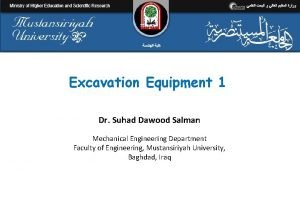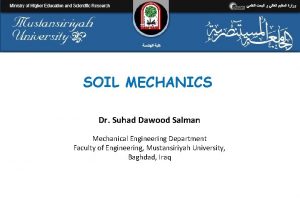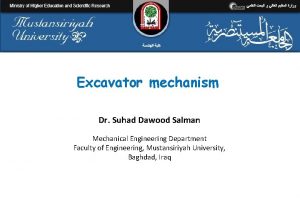FRONT SHOVELS Dr Suhad Dawood Salman Mechanical Engineering









- Slides: 9

FRONT SHOVELS Dr. Suhad Dawood Salman Mechanical Engineering Department Faculty of Engineering, Mustansiriyah University, Baghdad, Iraq

Front shovels operate very similarly to front-end loaders; they are designed to dig above grade into the face of the excavation, not to scoop at ground level. These shovels typically operate on tracks for better traction when pushing the bucket into the face to be excavated. The work typically entails filling the bucket, backtracking or positioning and dumping the bucket contents into a pile or a truck. Front shovels are typically not very mobile and travel distance minimized. Some shovels are equipped with bottom dump buckets to reduce wear on the machine and provide greater dumping and loading accuracy.

Front shovels excavate above grade or into a material face or pile above the operating surface. Their production cycle is similar to an excavator: dig, backtrack, dump, reposition, and start over. Shovels digging into dense material typically operate on tracks. Shovels used for material rehandling where digging is not required might operate on tires. Front-end loaders operate similarly to front shovels, but are made for scooping at ground level, not excavating. They are classified similarly by their upward scooping motion. For optimum depth of cut, the bucket should be filled when it reaches the top of the face in one pass. This depends on the type of material and the size of the bucket.

Optimum digging height for most shovels is between 40 and 50% of the rated maximum digging height. Breakout force is developed by crowding the material away from the shovel by pushing the bucket teeth into the material face and curling the bucket upward and toward the machine. Equipment packages will vary based on the volume of work, desired productivity, equipment availability, and specific work conditions and needs.

The excavator is used for: • digging operations • levelling operations • pushing operations • load and carry operations • handling loads similar to crane • mounting other equipment and acting as a tool carrier • preparing and levelling stock storage pads • towing loads and other equipment similar to a tractor • General clean up of work areas.

TABLE: Earthmoving and Excavating Work Activities and Equipment Packages.

The digging operation should be carried with: 1 - Set the edge of the bucket facing slightly down. 2 - Drive the excavator forward and operate the lift arm control lever forward to cut a thin layer of the surface each time when excavating the soil. 3 - Operate the lift arm control lever slightly up and down to reduce the resistance when driving the excavator forward. When digging with the bucket, avoid imposing the digging force onto only one side of the bucket.


Thank you for listening















